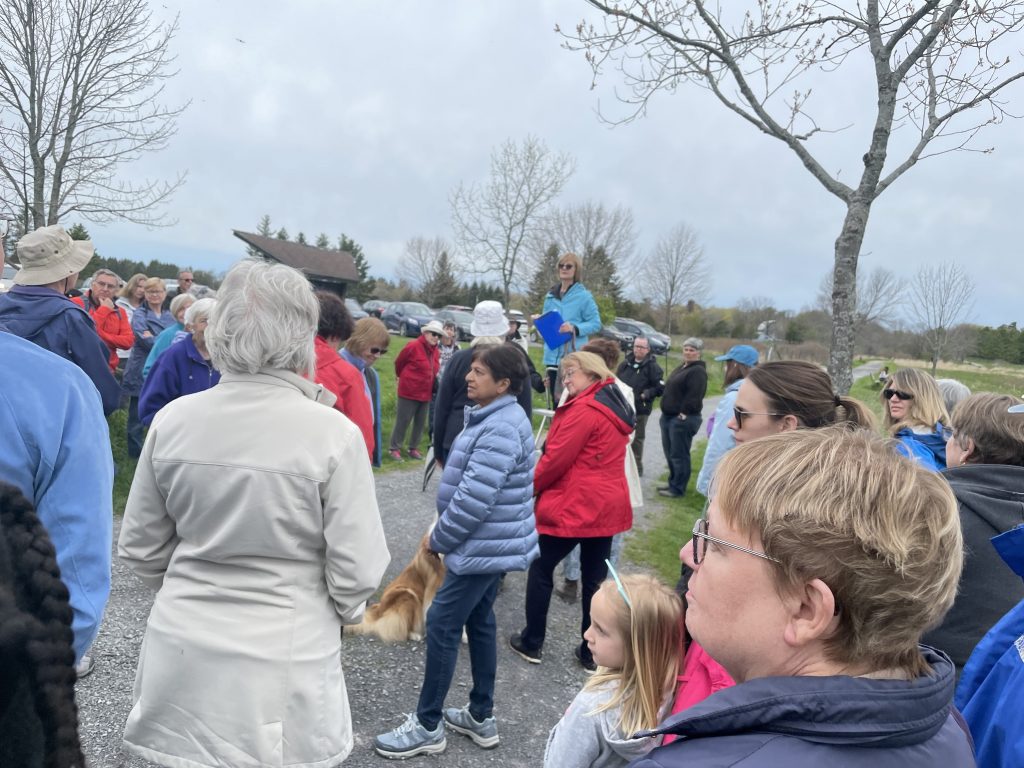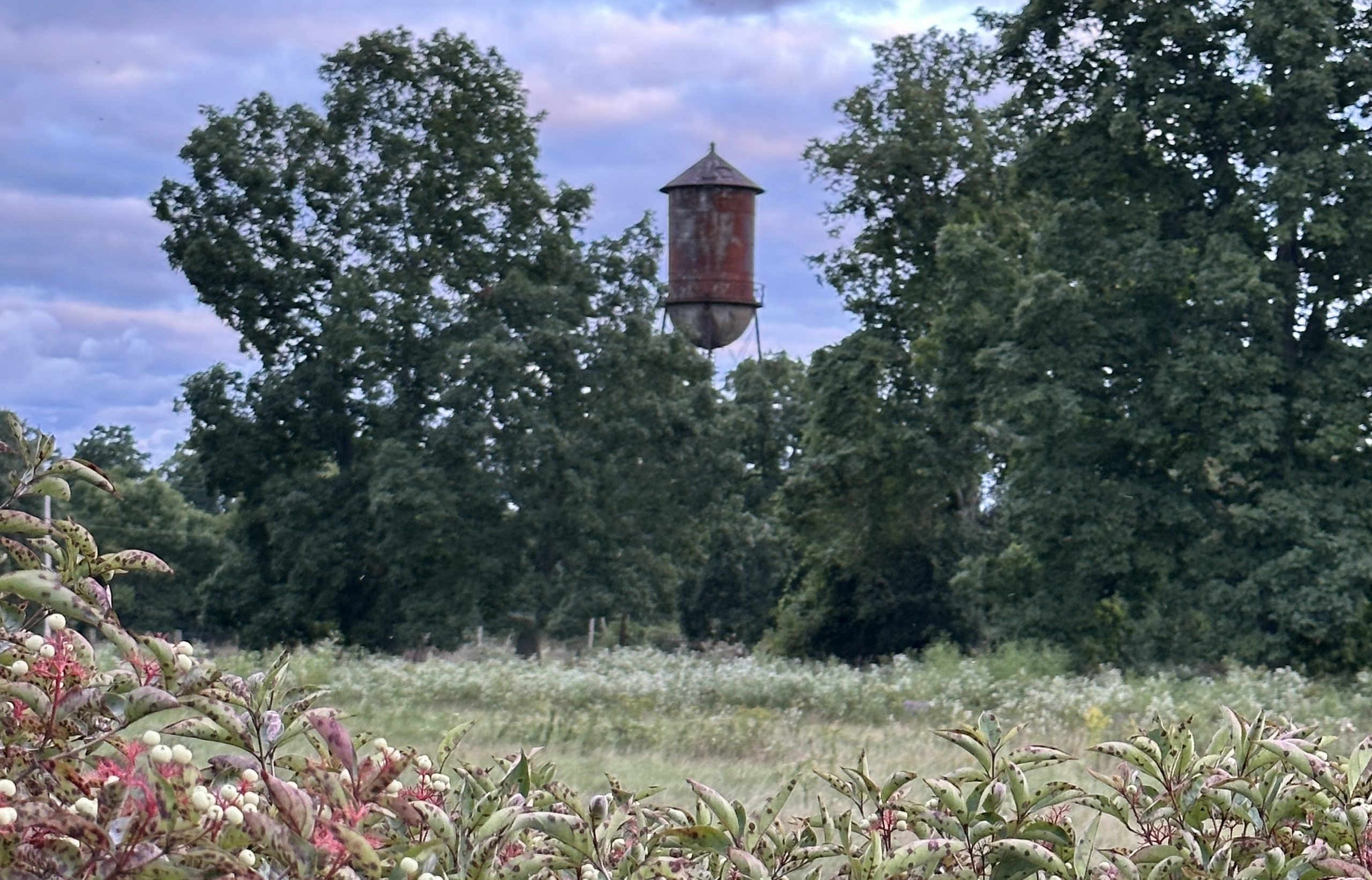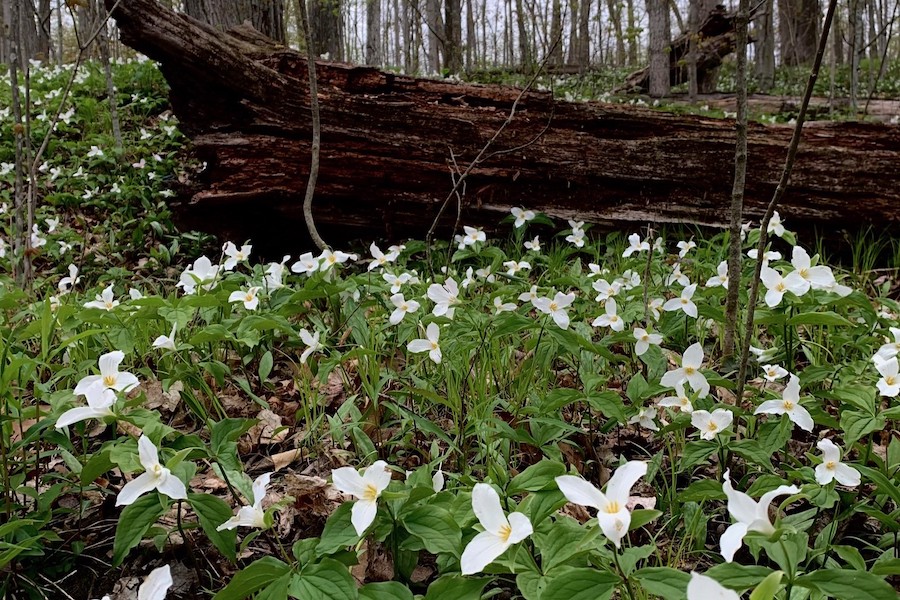
Shelagh Mirski, blue jacket and navy folder, welcoming people to the Jane’s Walk.
Spring was in the air when, despite the promise of rain, about 80 people gathered at the south parking lot of the Lemoine Point Conservation Area, excited to participate in a Jane’s Walk along the Farm property line and learn more about its history.
Shelagh Mirski welcomed everyone on behalf of the hosts, the Save Lemoine Point Farm group. She paid her respects to Indigenous peoples who were on this land long before settlers, and noted that the walk focus is on colonial and recent times.
At the first stopping point, Shelagh pointed out the land owned by the Conservation Authority, including a small forest recently planted to see which Carolinian tree species might do well here as the climate changes.
The Farm’s Ownership History
Susan Young, an occasional columnist in the Whig Standard and a current tenant on the Farm, provided some of its history:
The first owner, under the colonial land registry system, was Madelaine de Roybon d’Allone who was also the first woman landowner in New France. She was granted the land by René-Robert Cavelier de La Salle in the beginning of the 1700s.
In 1763, France lost its war with Britain and Louis XV ceded the lands to the British. A reward of 3,450 acres was given to Johan Jost Herkimer for his service to Britain during the American War of Independence.
Herkimer’s son, Nicholas, built the first homestead on the property. The land was subsequently owned, in 1836, by Captain William Henry Lemoine, a retired British miliary officer. He built a house in 1850. He died in 1865 leaving the property to his wife and son.
William Coverdale, the CEO of the Great Lakes Steamship Company, bought 450 acres in 1914 and began living on the property as his full-time home in the 1920s. He had four children, one of whom was Mary Winnett.
The Coverdales began farming the land in earnest and had cattle, sheep, a thriving garden, and a dairy.
There was also a large boathouse at the lake and, at one time, a golf course for the family.
In 1976, three of the four Winnett children sold their share of the farm, about 340 acres, to the Cataraqui Region Conservation Authority, creating the urban nature park appreciated by so many people over the years. The purchase was funded by the Township of Kingston, the City of Kingston, and the Province of Ontario.
Mary Winnett, and then her daughter Mary Fraser, continued farming the remaining 80 acres, in more recent years with the help of farm manager, Jesse Archibald. Mary Winnett died in February 2007. Mary Fraser died in April 2022.
The Farm is now dormant awaiting its future.
Residents Fought to Protect the Land from Development in the 1990s
Shelagh Mirski, President of the Association to Protect Lemoine Point, described the fight against residential development on part of the farm:
In 1990, a developer, Ross Grieve, had a plan to build a subdivision on the southern 23 acres of the Farm. Thanks to the watchful eye of nearby resident, Chris Cannon, the public became aware of the plan that was making its way through the Kingston Township planning process.
A majority of the Township Council argued that market forces should determine land use and said it was unfair not to let farm owners sever their property for development.
In April 1990, the Township Council approved, in principle, changes to the Official Plan to allow the subdivision.
A group of concerned residents formed the Association to Protect Lemoine Point and Shelagh became its spokesperson. She worked with many other dedicated residents who did not want to see valuable green space on Lake Ontario and a working farm lost to housing. Many were concerned that because of the high cost of bringing water and sewer over a mile down the road, the entire 80-acre farm would be lost. In addition to the loss of the farm, a subdivision on the boundary of the Conservation Area would lead to its environmental degradation.
She remarked on how different organizing was in 1990s, before cell phones, email, and social media. The group went door-to-door, held meetings, and did newspaper, TV, and radio interviews to inform people about what was being proposed. Support came from many sources, including pilots who did not want to see housing below the frequently used east/west runway.
A Township Council meeting to set the date for an official public meeting to amend the Official Plan and the Zoning By-law attracted 100 people. A petition gathered 8,000 signatures in ten days. The next public meeting took place in the Frontenac Secondary School gym and 500 people showed up. 40 people spoke against the development, each focussing on different arguments. Only one person aside from the developer supported the subdivision proposal.
Then it turned out that one of the Township councillors was a business partner of the developer and he was forced to withdraw from voting on the matter.
In November 1991, the municipal election results testified to public sentiment about the subdivision proposal. None of the four councillors who supported it were re-elected.
Eventually, the developer withdrew his application, the Association to Protect Lemoine Point faded into the background, and a new group, the Friends of Lemoine Point, was formed to support the Conservation Authority’s management of the conservation area. It is still active planting trees, fighting invasive species, collecting seeds, and running the native plant nursery.
Shelagh reflected on the reasons her group was successful in the face of the challenges posed by an unwelcome development and a supportive Township Council.
She said they:
- Found out about the rules that were in play – how Official Plans and Zoning By-laws can be amended, what polices must be followed
- Spoke up at every available opportunity
- Informed people and asked them to get involved
- Focused their messages in the media
- Had many voices speaking at meetings
- Were lucky with the timing of the municipal election.
Shelagh finished her remarks by telling people that the Save Lemoine Point Farm group wants to see the Farm used for the public good, and never subdivided. She thanked people for attending the Jane’s walk and encouraged them to keep in touch, to speak up, and to show up when needed.


